 |
|
|||
 |
 |
|||
Copyright © Harry Rinker, LLC 2017 Questions
and Answers
QUESTION: I received a 62-inch by 85-inch woolen blanket from my mother. She bought it in the early 1950s when she and her best girlfriends went on a road (possibly train) trip to the west coast, ending up in California. The round label attached to the blanket reads: “GLACIER PARK BLANKET / PENDLETON WOOLEN MILLS / PENDLETON, OREGON.” My husband and I used it on our bed until we were transferred to Florida in the 1980s. I had it dry-cleaned and have stored it since. I am curious as to its current value? – SS, Bozeman, MT, Email Question 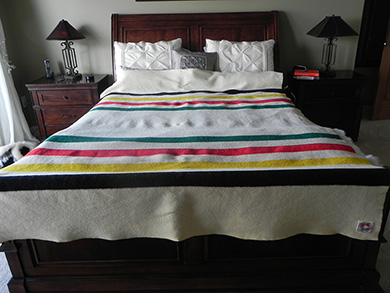
ANSWER: In 1901, Clarence, Roy, and Chauncy Bishop revitalized a Pendleton, Oregon woolen mill that previously made bed blankets and robes for Native Americans. Production of Native American blankets resumed. Beginning with designs that appealed to the Nez Perce nation, the product line soon expanded to blankets and robes for the Hopi, Navajo, and Zuni nations. Pendleton Woolen Mills expanded its line in the mid-1920s to include men’s shirts and in 1949 women’s wear. [For more information, see: www.pendleton-usa.com/custserv/custserv.jsp?pageName=CompanyHistory&parentName=Heritage] Shortly after Montana’s Glacier National Park was established in 1910, James J. Hill, a Canadian-American railroad entrepreneur and CEO of a combination of railroads operating as the Great Northern Railroad, asked Pendleton Woolen Mills to create a blanket design to be used exclusively at lodges in Glacier National Park. Pendleton designers incorporated seasonal colors associated with the park in the design. Since its debut in 1916, the Glacier National Park blanket has been in continuous production. Today, there are ten Pendleton Woolen Mills National Park blanket designs—Arcadia, Badlands, Carter Lake, Glacier, Grand Canyon, Great Smoky Mountains, Mount Rainier, Rocky Mountain, Yellowstone, and Yosemite. The individual blanket tags capture the design of vintage souvenir window stickers presented to motorists who visited the parks. [For more information, see: www.pendleton-usa.com/custserv/custserv.jsp?pageName=NationalParks&parentName=Heritage] As noted earlier, the Glacier National Park blanket, identical to the one you own, is still being made. Pendleton Woolen Mills lists a queen size Glacier National Park blanket for $269.00. Blackcountry.com lists it at $258.95 but offers a 20% off coupon. This is an instance where “new” trumps “old.” Values for older examples range from 30 to 60 percent of modern retail. A strong secondary market value for an older example of the Glacier National Park Blanket in near mint condition and with excellent color is between $100.00 and $125.00. Lesser condition examples are available for under $75.00. 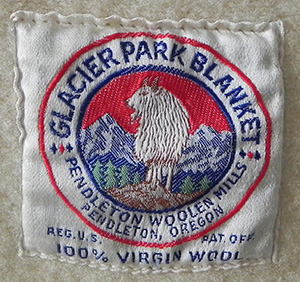
QUESTION: Could you please tell me if there is a place to test if glass is irradiated? I have a Lalique vase that has been appraised in the past for a decent value. When I attempted to sell it at auction, I was informed that the piece had been irradiated and subsequently has little value. I did not know glass could be irradiated. The piece has a deep blue color. I would like to test it to see if the color is period or not. – AB, Email Question ANSWER: Irradiation, the exposure of glass to radiation to change its color, has been practiced by glass manufacturers for over 40 years. Unscrupulous antiques and collectibles collectors and dealers have been using the technique since the 1990s to create “scarce” and/or “unique” colors in a wide assortment of historic and modern glassware. In addition to irradiation, exposing glass to high doses of sunlight/heat also results in color change. Mark Chervenka’s article entitled “Irradiation Changes Color of Glass” [www.realorrepro.com/article/Irradiation-Changes-Color-of-Glass] provides the following information on testing for irradiation: “Contrary to rumors, a Geiger counter cannot be used to detect irradiated glass. Irradiated glass, remember, is not radioactive. Determining whether a piece of glass has been irradiated is not easy. A small portion of the glass must be tested in a laboratory which can cost $125-$250. The tests determine whether the glass' color is created by chemical ingredients or irradiation. The element manganese, for example, was used both as a decolorizer and a coloring agent. When used as a decolorizer, it shows up as less than 1%, usually only a few tenths or even hundredths of one percent. When used as a coloring agent to intentionally make glass purple, however, manganese content rises to 4% to 30%. Thus, if a piece of deep purple glass is tested and found to contain less than 1% manganese, it has been irradiated. “A simpler less expensive test is to heat the suspected item. Depending on the glass formula, the color will begin to fade at about 300 to 700 degrees F. This generally returns the glass to its original color usually within an hour. The higher the original melting point of the glass, the higher the temperature required to reverse the color. Fruit jars, for example, made of heat resistant glass required temperatures approaching 600-800 degrees F to reverse the color. This test is not without danger because too sudden an increase or decrease of temperature may damage the item being studied. Another test, although less reliable, is to simply place the suspected piece in direct sunlight (ultraviolet light) which will cause the color to fade.” I strongly suspect your piece has been irradiated. The “deep purple” color is a giveaway. Lalique glass was a favorite target of the irradiators during the late 1980s and 1990s Golden Age of Lalique collecting. Before spending the money to test your vase, consult books written about Lalique. Hopefully, the authors made certain that only period pieces and colors were illustrated. If you do not find Lalique pieces of the same color hue, then save your money and accept the inevitable. QUESTION: My bachelor uncle, who is responsible for my interest in antiques and collectibles, was a career Navy man. He enlisted as a young man. His mine sweeper, “USS Robin,” was en route to Hawaii from Johnson Island when the attack on Pearl Harbor occurred. I have his sterling silver tie bar with a blue cabochon in the middle and a pair of matching cufflinks. What is their value? -- KT, Madisonville, KY 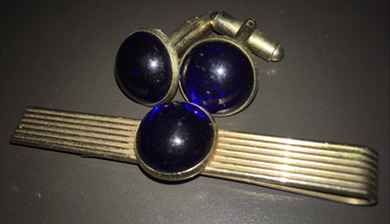
ANSWER: Although I found dozens of “naval” themed cufflinks and tie bar and cufflink sets, I could find no evidence that these were “official” naval issue. Apparently, naval personnel had a great deal of discretion as to the type and decoration on tie bars and cufflinks. There was one restriction. Officers were to use gold. Silver was required for individuals of the rank E6 and below. You did not indicate if the set had a manufacturer’s mark, most likely found on the tie bar. Hickok, Krementz, and Swank are three of the leading manufacturers. It would be ideal if a picture of your uncle in uniform with the tie bar and cufflinks visible existed. I suspect this does not. Given the above, your tie bar and cufflinks sets has a secondary market value between $15.00 and $20.00. Hopefully, its sentimental value to you is much higher. QUESTION: I have a 20-inch diameter wooden tray that is signed on the back “Robert T. Hogg Jr. 1941.” The front contains a pair of Pheasants painted by George W. Reinbold. I was wondering how much it was worth. – MC, Reading, PA, Email Question 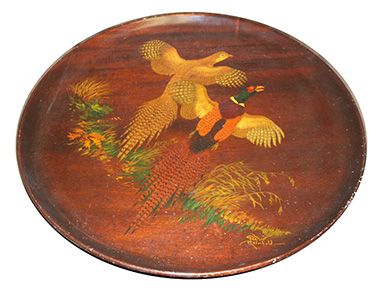
ANSWER: Robert T. Hogg, Jr., a cabinet maker, opened his shop located near Oxford, Pennsylvania, in 1936. He specialized in creating reproductions of American colonial era furniture. He also produced a variety of turned wood pieces, such as wooden trays, for the gift shop trade. His legacy continues in the Robert Treat Hogg Cabinet Shop, a group of craftsman still manufacturing reproductions and other hand crafted wooden items. 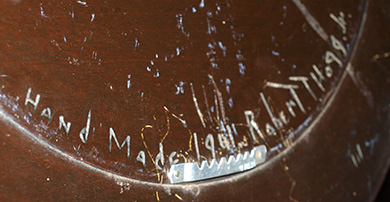
George Wilmer Reinbold (March 4, 1885 to December 14, 1946) attended Bloomsburg College in Pennsylvania and studied at the Philadelphia School of Industrial Arts. Following graduation, he worked for the Williamsport [PA] “Grit” and then the Photo Chromotype Company of Philadelphia. In 1933, the Reinbold family moved to Media, Pennsylvania, and then to Lansdowne, Pennsylvania. While residing in Lansdowne, Reinbold began carving duck and horse sculptures, the latter his favorite. He was assisted by his wife Emma, and daughter Margaret (Peg). In addition to his sculptures, he painted animals and birds on ceramic plates and wooden trays. The latter were sold in Abercrombie & Fitch, Caldwell’s, and gift shops. [For more information, see: http://www.windymeadowstudios.com/bios/GeorgeW%20I.htm] When they appear on the secondary market at auction, Reinbold’s decoys and horses command from the high hundreds to low thousands. Wildlife bird themed trays, especially those made by Hogg, realize between $150.00 and $200.00. 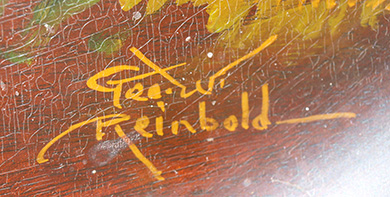
Harry L. Rinker welcomes questions from readers about
collectibles, those mass-produced items from the twentieth and twenty-first centuries.
Selected letters will be answered in this column.
Harry cannot provide personal answers.
Photos and other material submitted cannot be
returned.
Send your questions to: Rinker on Collectibles, 5955 Mill
Point Court SE, Kentwood, MI 49512.
You also can e-mail your questions to
harrylrinker@aol.com.
Only e-mails containing a full name and mailing address
will be considered.
You can listen
and participate in
WHATCHA GOT?, Harry’s
antiques and collectibles radio call-in show, on Sunday mornings between 8:00 AM
and 10:00 AM Eastern Time.
If you
cannot find it on a station in your area,
WHATCHA GOT?
streams live on the Internet at www.gcnlive.com.
SELL, KEEP OR TOSS?: HOW TO DOWNSIZE A HOME,
SETTLE AN ESTATE, AND APPRAISE PERSONAL PROPERTY
(House of Collectibles, an imprint of Random House Information Group, $17.99),
Harry’s latest book, is available at your favorite bookstore and via
www.harryrinker.com.
|
||||